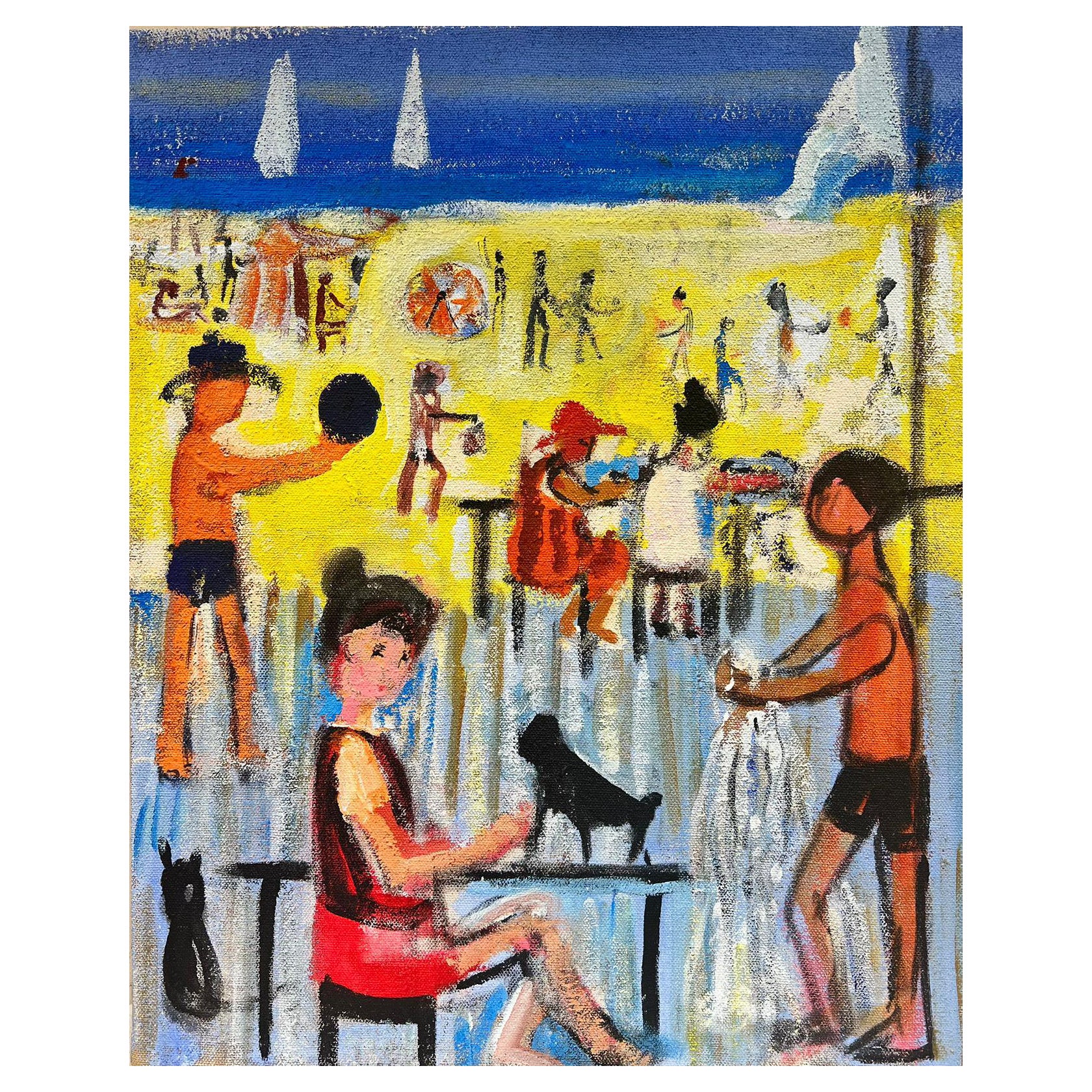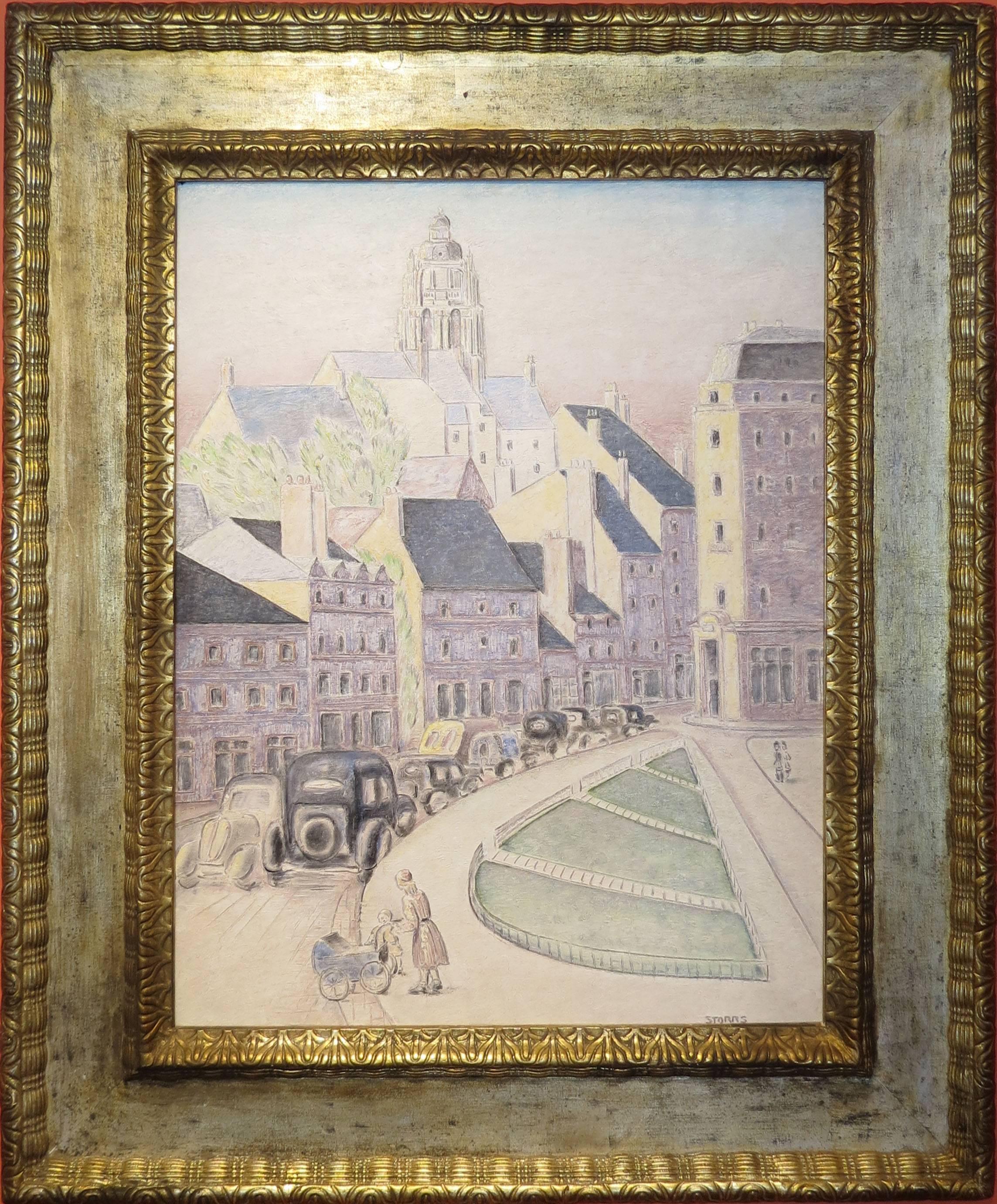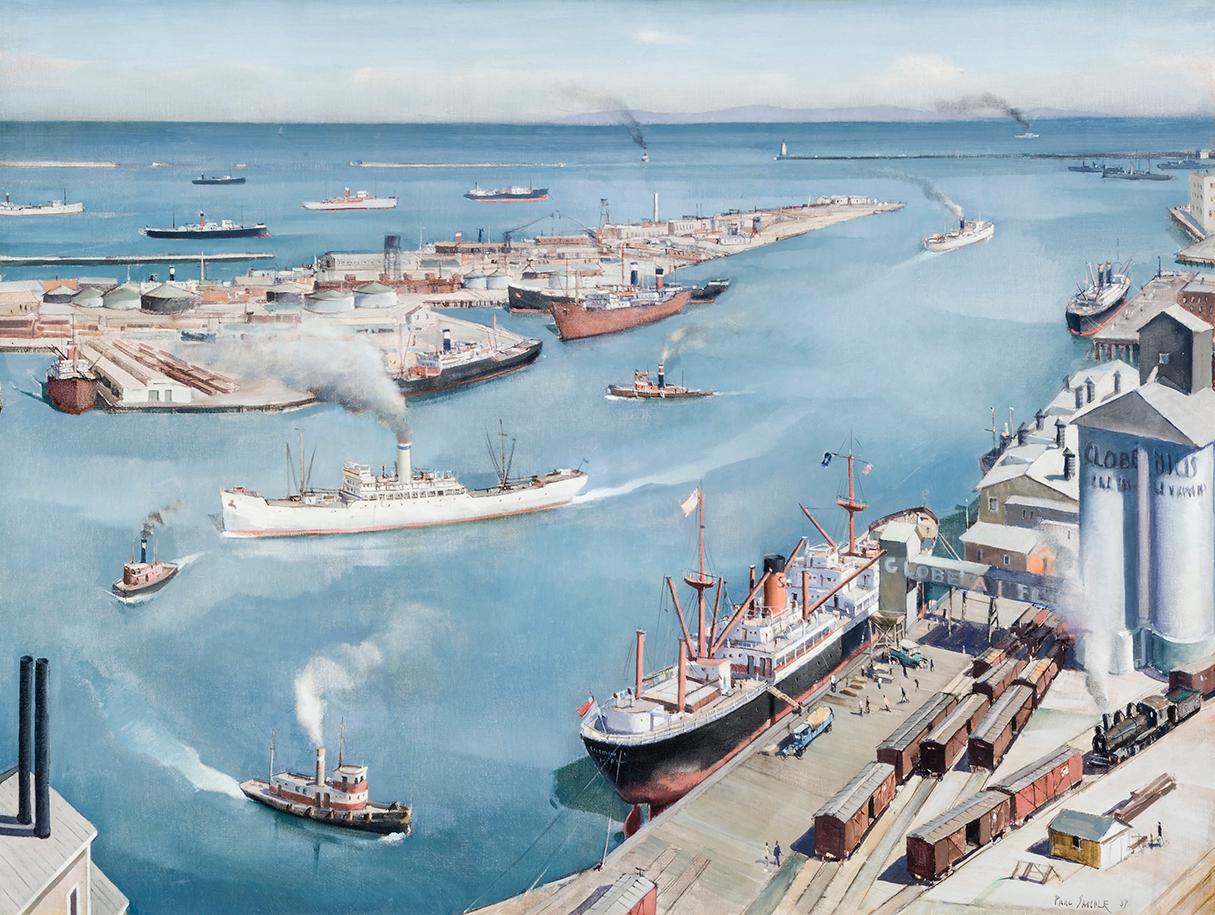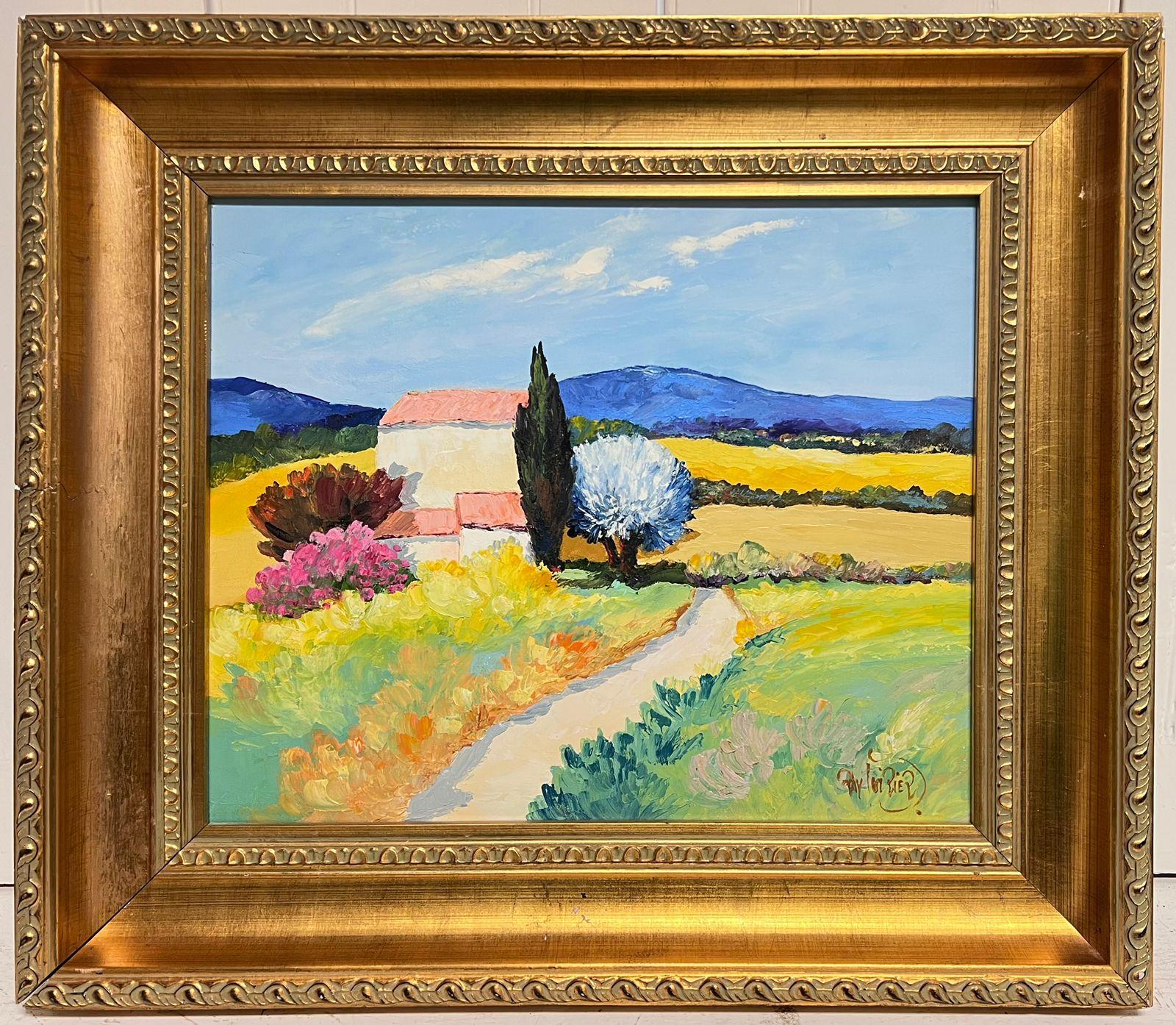Jules CavaillesLe Train de Banlieue
About the Item
- Creator:Jules Cavailles (1901 - 1977)
- Dimensions:Height: 28.74 in (73 cm)Width: 18.11 in (46 cm)
- Medium:
- Movement & Style:
- Period:
- Condition:
- Gallery Location:Rancho Santa Fe, CA
- Reference Number:1stDibs: LU51631442293
Jules Cavailles
Jules Cavaillès was a painter whose art expressed the joy of living. Cavaillès was born on June 20, 1901, in Carmaux. He adored cheerful images that conjured up the pleasures of life, like sunny harbor scenes viewed through open windows, the lush countryside, naked women, colorful flowers in decorative interiors and even lobsters. He composed and recomposed this selected reality at leisure, presenting it through objects gleaned like repositories of memories, and he infused his art with life, thanks to pure colors stroked by a soft light. To quote Delacroix, Jules Cavaillès’s paintings are "a feast for the eye." He exhibited widely and won several prizes and his paintings are represented in major collections such as the Museum of Modern Art in Paris and the municipal art galleries of Albi, Marseille, Montpellier, Toulouse, Chicago, Helsinki, Tel Aviv and Zurich. Cavaillès died on January 29, 1977, in Épineuil.
- ShippingRetrieving quote...Ships From: Rancho Santa Fe, CA
- Return PolicyThis item cannot be returned.
- #16 Remote ForegroundLocated in Rancho Santa Fe, CAOil on canvas 13 x 20 inches Signed and dated center right: "Matthew Spender / 1981" Titled on canvas overlap verso: "#16 Remote Foreground" Retail: $2...Category
1980s Post-War Figurative Paintings
MaterialsCanvas, Oil
- "Vent Léger en Aout (Trouville)" "Light Wind in August" Plage sailboat beach o/cBy André HambourgLocated in Rancho Santa Fe, CAA wonderful André Hambourg beach scene at Trouville with people, children, sailboats, dogs, horses, birds, cabanas & umbrellas! Signed lower left Initialed and titled verso. Framed dimensions: 20 x 27.5 inches Wally Findley inventory number (verso) - 81838 Provenance: Wally Findlay...Category
Mid-20th Century Impressionist Landscape Paintings
MaterialsCotton Canvas, Oil
- Sunset in the Sierra's 1942 - California Mountain Landscape oil on canvas framedBy Robert William WoodLocated in Rancho Santa Fe, CAHoused in a period, hand carved, gold leaf frame. Dimensions: 28 x 36 inches Signed and dated Robert Wood ‘42 Provenance: Private Collection, Cleveland, Ohio Dr. S. Robbins, Cleve...Category
1940s American Impressionist Landscape Paintings
MaterialsOil, Canvas
- Meenakshi Temple Hindu Priest & Sacred Elephant Madurai Tamil India 1913 o/cLocated in Rancho Santa Fe, CAAndre Chéronnet Champollion Meenakshi Temple Hindu Priest & Sacred Elephant Madurai, Tamil Oil on canvas Painting Dimensions: 36 x 28 inches Framed Dimensions: 44.5 x 36.5 inches Sig...Category
1910s Other Art Style Landscape Paintings
MaterialsCanvas, Oil
- Sailboats Docked - Saint-Mandrier, Toulon, FranceBy Georges Jules Ernest BinetLocated in Rancho Santa Fe, CABorn in Le Havre in 1865, Binet painted both in Paris and in Normandy, capturing scenes of modern, everyday life. A pupil of Francois Cormon and Raphael Collin, he is known for his n...Category
Early 20th Century Impressionist Landscape Paintings
MaterialsCanvas, Oil
- Swedish Landscape - Colorful Expressionist Blue Green - SwedenBy Sixten LundbohmLocated in Rancho Santa Fe, CALundbohm grew up in Fritsla, Sweden where his father was a fisherman. Sixten Lundbohm graduated in Gothenburg in 1913, and studied art history at the University of Gothenburg and at the same time studied at Valand's evening school. In the spring of 1914 he also attended Valand's painting school with Axel Erdmann as a teacher and started the autumn of the same year at Wilhelmson's paint school in Stockholm. Throughout his career, Lundbohm made a large number of painting trips in Europe, primarily to France and Spain, but also Norway and Denmark . His southern landscape and architecture motifs have a strict and monumental structure, akin to Ivan Aguéli...Category
Mid-20th Century Expressionist Landscape Paintings
MaterialsOil, Canvas
- Large French Contemporary Modernist Oil Painting Figures Playing on Sunny BeachBy Huguette Ginet-LasnierLocated in Cirencester, GloucestershireBeach Games Huguette Ginet-Lasnier (French 1927-2020) oil painting on textured canvas 29 x 24 inches. All the paintings we have for sale by this artist have come from the artists estate in France. The painting is in very good and presentable condition. Color: Pink, green, black and white Ginet-Lasnier, the wife of the painter Jean Lasnier...Category
21st Century and Contemporary Modern Landscape Paintings
MaterialsOil, Canvas
- "Cityscape at Dusk"By John Bradley StorrsLocated in Lambertville, NJSigned Lower Right John Bradley Storrs (1885 - 1956) Born and raised in Chicago, John Storrs was a pioneer modernist sculptor known for his precisely executed, solid, non-objectiv...Category
20th Century Modern Landscape Paintings
MaterialsCanvas, Oil
- San Pedro HarborBy Paul SampleLocated in New York, NYIt is infrequent, to say the least, that a diagnosis of tuberculosis proves fortuitous, but that was the event, in 1921, that set Paul Starrett Sample on the road to becoming a professional artist. (The best source for an overview of Sample’s life and oeuvre remains Paul Sample: Painter of the American Scene, exhib. cat., [Hanover, New Hampshire: Hood Museum of Art, 1988] with a detailed and definitive chronology by Sample scholar, Paula F. Glick, and an essay by Robert L. McGrath. It is the source for this essay unless otherwise indicated.) Sample, born in Louisville, Kentucky, in 1896 to a construction engineer and his wife, spent his childhood moving with his family to the various locations that his father’s work took them. By 1911, the family had landed in Glencoe, Illinois, settling long enough for Paul to graduate from New Trier High School in 1916. Sample enrolled at Dartmouth College, in Hanover, New Hampshire, where his interests were anything but academic. His enthusiasms included the football and basketball teams, boxing, pledging at a fraternity, and learning to play the saxophone. After the United States entered World War I, Sample, to his family’s dismay, signed on for the Naval Reserve, leading directly to a hiatus from Dartmouth. In 1918 and 1919, Sample served in the U.S. Merchant Marine where he earned a third mate’s license and seriously contemplated life as a sailor. Acceding to parental pressure, he returned to Dartmouth, graduating in 1921. Sample’s undergraduate life revolved around sports and a jazz band he formed with his brother, Donald, two years younger and also a Dartmouth student. In November 1933, Sample summarized his life in a letter he wrote introducing himself to Frederick Newlin Price, founder of Ferargil Galleries, who would become his New York art dealer. The artist characterized his undergraduate years as spent “wasting my time intensively.” He told Price that that “I took an art appreciation course and slept thru it every day” (Ferargil Galleries Records, circa 1900–63, Archives of American Art, Smithsonian Institution, available on line). In 1920, Donald Sample contracted tuberculosis. He went for treatment to the world-famous Trudeau Sanitorium at Saranac Lake, in New York State’s Adirondack Mountains for the prescribed regimen of rest, healthful food, and fresh air. Visiting his brother in 1921, Paul also contracted the disease. Tuberculosis is highly contagious, and had no certain cure before the development of streptomycin in 1946. Even for patients who appeared to have recovered, there was a significant rate of recurrence. Thus, in his letter to Price, Sample avoided the stigma conjured by naming the disease, but wrote “I had a relapse with a bad lung and spent the next four years hospitalized in Saranac Lake.” The stringent physical restrictions imposed by adherence to “the cure” required Sample to cultivate an alternate set of interests. He read voraciously and, at the suggestion of his physician, contacted the husband of a fellow patient for instruction in art. That artist, then living in Saranac, was Jonas Lie (1880–1940), a prominent Norwegian-American painter and an associate academician at the National Academy of Design. Lie had gained renown for his dramatic 1913 series of paintings documenting the construction of the Panama Canal (The Metropolitan Museum of Art, New York; United States Military Academy, West Point, New York). Primarily a landscape artist, Lie had a particular affinity for scenes with water. His paintings, impressionistic, atmospheric, and brushy, never strayed from a realistic rendering of his subject. Sample regarded Lie as a mentor and retained a lifelong reverence for his teacher. Sample’s early paintings very much reflect Lie’s influence. ` In 1925, “cured,” Sample left Saranac Lake for what proved to be a brief stay in New York City, where his veteran’s benefits financed a commercial art course. The family, however, had moved to California, in the futile hope that the climate would benefit Donald. Sample joined them and after Donald’s death, remained in California, taking classes at the Otis Art Institute in Los Angeles. In Sample’s account to Price, “I couldn’t stomach the practice of painting a lot of High Sierras and desert flowers which seemed to be the only kind of pictures that were sold here so I got a job teaching drawing and painting at the art school of the University of Southern California.” Initially hired as a part-time instructor, Sample progressed to full-time status and ultimately, by the mid-1930s, to the post of Chairman of the Fine Art Department. Sample, however, did not want to wind up as a professor. “Teaching is all right in small doses,” he wrote, “but I have a horror of drifting into being a college professor and nothing more.” At the same time as he taught, Sample began to exhibit his work in a variety of venues at first locally, then nationally. Though he confessed himself “a terrible salesman,” and though occupied with continued learning and teaching, Sample was nonetheless, ambitious. In 1927, he wrote in his diary, “I am eventually going to be a painter and a damned good one. And what is more, I am going to make money at it” (as quoted by Glick, p. 15). In 1928, Sample felt sufficiently solvent to marry his long-time love, Sylvia Howland, who had also been a patient at Saranac Lake. The Howland family were rooted New Englanders and in summertime the Samples regularly traveled East for family reunion vacations. While the 1930s brought serious hardship to many artists, for Paul Sample it was a decade of success. Buttressed by the financial safety net of his teacher’s salary, he painted realist depictions of the American scene. While his work addressed depression-era conditions with a sympathetic eye, Sample avoided the anger and tinge of bitterness that characterized much contemporary realist art. Beginning in 1930, Sample began to exhibit regularly in juried exhibitions at important national venues, garnering prizes along the way. In 1930, Inner Harbor won an honorable mention in the Annual Exhibition of the Art Institute of Chicago. That same year Sample was also represented in a show at the Albright-Knox Gallery in Buffalo and at the Biennial Exhibition of the Corcoran Gallery of Art, Washington, D.C. In 1931, Dairy Ranch won the second Hallgarten Prize at the Annual Exhibition of the National Academy of Design, in New York. Sample also made his first appearances at the Carnegie Institute, Pittsburgh, and The Pennsylvania Academy of the Fine Arts, Philadelphia. In 1936, Miner’s Resting won the Temple Gold Medal at the Pennsylvania Academy’s Annual Exhibition. Always interested in watercolor, in 1936, Sample began to send works on paper to exhibitions at the Whitney Museum, New York. While participating in juried exhibitions, Sample also cultivated commercial possibilities. His first New York art dealer was the prestigious Macbeth Gallery in New York, which included his work in a November 1931 exhibition. In 1934, Sample joined the Ferargil Galleries in New York, after Fred Price arranged the sale of Sample’s Church Supper to the Michele and Donald D’Amour Museum of Fine Arts in Springfield, Massachusetts. In 1937, The Metropolitan Museum of Art purchased Sample’s Janitor’s Holiday from the annual exhibition of the National Academy of Design, a notable honor. As prestigious as this exhibition schedule may have been, by far Sample’s most visible presence in the 1930s and 1940s was the result of his relationship with Henry Luce’s burgeoning publishing empire, Time, Inc. Sample’s first contribution to a Luce publication appears to have been another San Pedro...Category
20th Century American Modern Landscape Paintings
MaterialsCanvas, Oil
- Spring in Dorset, 20th Century English Oil Landscape, Female ArtistLocated in London, GBOil on board Image size: 12 1/2 x 15 1/2 inches (31.75 x 40 cm) Contemporary style handmade frame Exhibitions 1952 Royal Academy of Arts Exhibition, Gallery no. VII, no.429. This forest scene invites the viewer into a multi-sensory event where the cool, damp shadows of the foliage can almost be felt and the rich bouquet of the forest floor recalled. Here, Sherlock has chosen a somewhat unusual angle and composition, dissecting each truck and tree form so that only a part can be seen. Furthermore, as we look into the depths of this space it becomes clear that we are stood gazing down into a valley that is in the distance, behind this wooded area. Indeed, instead of giving us an uninterrupted view of this vista, as perhaps would be expected, this view is deliberately blocked and our focus is directed instead towards the organic forms in the foreground. The Artist Marjorie Sherlock was born at Fir Tree Cottage, George Lane, Wanstead, Essex, on 3 February 1891, the elder child of the civil engineer, Henry Sherlock, and his wife, Alice (née Platts), who was born in Benares, India. By 1901, the family was living at ‘The Limes’, 121 Mill Road, Cambridge, and Marjorie received an education locally. In 1918, she entered into marriage with her cousin, Major Wilfrid Barrett, though this proved unsuccessful and they later divorced (he remarrying in 1941). She then continued to live at the family home until the Second World War. During the First World War, Marjorie Sherlock studied at Westminster Technical Institute under the Camden Town School painters, Walter Sickert and Harold Gilman. She exhibited at the Royal Academy of Arts from 1917, when she showed a powerful view of the interior of Liverpool Street Station (Government Art Collection) (to which the current etching [202] relates). In time, she would exhibit at the International Society, the New English Art Club, the Royal Society of British Artists, the Society of 207 Graphic Art and the Women’s International Art Club (becoming a member of the last two). She also showed work internationally. Developing as a printmaker as well as a painter, Sherlock studied etching under Malcolm Osborne at the Royal College of Art in 1925. She published her etchings in four series, the titles of which indicate her love of travel: ‘English Etchings, ‘Egyptian Etchings’ (both 1925), ‘German Etchings’ (1929) and ‘Indian Etchings’ (1932). During this period, she also visited the united States. More admiring of Continental painters than British ones, she furthered her studies, in 1938, by working in Paris under André L’Hôte and André Dunoyer de Segonzac. During the Second World War, Sherlock moved to East Devon and settled at Oxenways, a Victorian hunting lodge...Category
1950s Modern Landscape Paintings
MaterialsCanvas, Oil
- The Little House in Provence Signed Original French Modernist Oil PaintingLocated in Cirencester, Gloucestershire"Le Mas" French Modernist artist, 21st century indistinctly signed lower corner oil on canvas, framed framed: 21.5 x 25.5 inches canvas: 15 x 18 inches provenance: private collection...Category
2010s Modern Landscape Paintings
MaterialsCanvas, Oil
- Till the Clouds Roll By 1945 Frank Sinatra Mid Century Modern Hollywood Film WPABy Richard WhorfLocated in New York, NYTill the Clouds Roll By 1945 Frank Sinatra Mid Century Modern Hollywood Film WPA TILL THE COULDS ROLL BY (Film Set), oil on canvas, 20 x 24 inches signed “Richard Whorf” lower right and signed and dated on the verso “R. Whorf/ Dec. 21, 1945. Frame by Hendenryk. ABOUT THE PAINTING This painting is from the collection of Barbara and Frank Sinatra, dated December 21, 1945 (just nine days after Frank Sinatra’s 30th birthday), and depicts the Metro-Goldwyn-Mayer Culver City backlot during the filming of Till the Clouds Roll By, the direction of the film having been taking over by Richard Whorf in December 1945. It is not presently clear if Whorf gave the Sinatras this painting as a gift, as the presence of the Dalzell Hatfield Galleries label on the verso indicates the painting may have been sourced there. Frank and Nancy Sinatra acquired a number of works from Dalzell Hatfield Galleries during the 1940’s, or perhaps they framed it for the couple. Sinatra performed “Old Man River’ in the film. Sinatra and June Allyson are depicted in the center of the painting. PROVENANCE From the Estate of Mrs. Nancy Sinatra; Dalzell Hatfield Galleries, Ambassador Hotel, Los Angeles. An image of the Dalzell Hatfield label and the back of the original frame (which we replaced with a stunning Heydenrk frame) are attached. Nancy Sinatra was Fran's first wife. Nancy Rose Barbato was 17 years old when she met Frank Sinatra, an 18-year-old singer from Hoboken, on the Jersey Shore in the summer of 1934. They married in 1939 at Our Lady of Sorrows Church in Jersey City where Frank gave Nancy a recording of a song dedicated to her titled "Our Love" as a wedding present. The young newlyweds lived and worked in New Jersey, where Frank worked as an unknown singing waiter and master of ceremonies at the Rustic Cabin while Nancy worked as a secretary at the American Type Founders. His musical career took off after singing with big band leaders Harry James and Tommy Dorsey...Category
1940s American Modern Landscape Paintings
MaterialsCanvas, Oil





